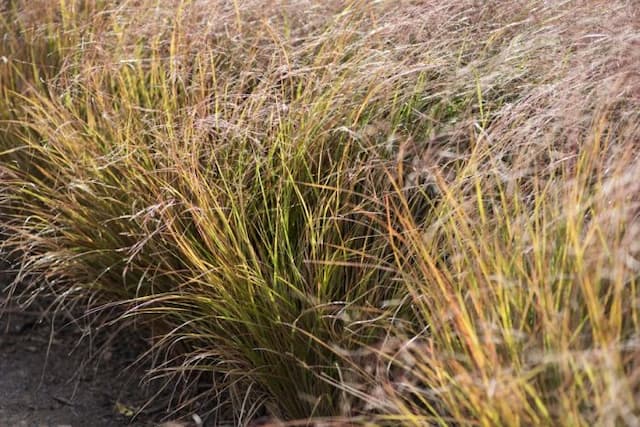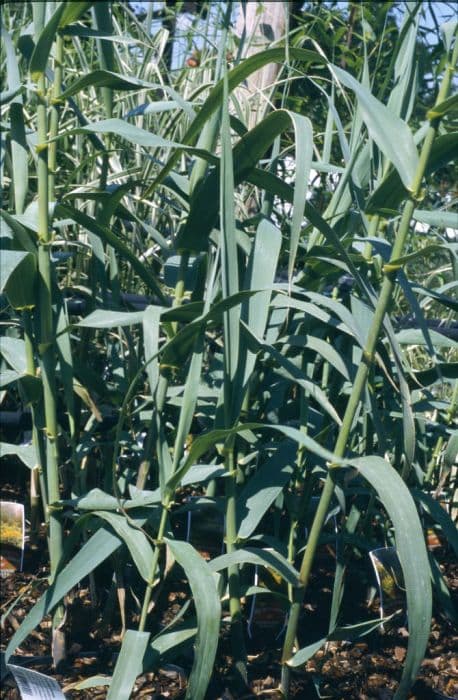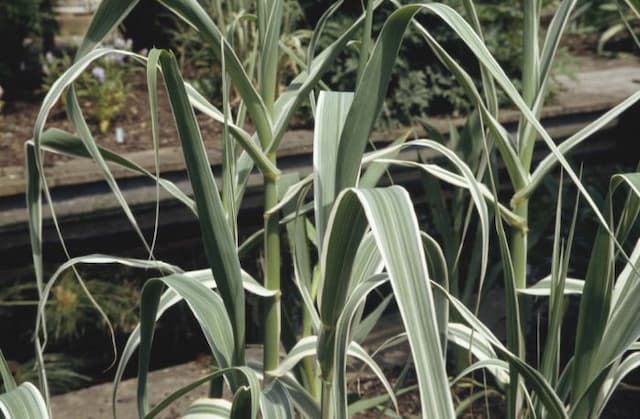Pampas Grass Cortaderia selloana 'Pink Phantom'

ABOUT
The Cortaderia selloana 'Pink Phantom', commonly known as Pink Pampas Grass, is a striking ornamental grass renowned for its distinctive fluffy plumes. These plumes boast a delicate pink hue, which adds a touch of gentle color to the landscape. The feathery texture of the plumes gives them an ethereal quality, and they appear to float above the tufted, grassy foliage. The leaves themselves are long, slender, and taper to a point, exhibiting a grayish-green color that contrasts nicely with the soft pink of the plumes. The arching nature of the leaves creates a dense and lush appearance, forming a fountain-like structure from the center of the plant. The Pink Pampas Grass is widely appreciated for its visual appeal and is often used as a statement piece in gardens and landscaping projects due to its unique coloration and elegant form.
About this plant
 Names
NamesFamily
Poaceae.
Synonyms
Pink Pampas Grass, Pink Phantom Pampas Grass.
Common names
Cortaderia selloana 'Pink Phantom'.
 Toxicity
ToxicityTo humans
Pampas grass, including the 'Pink Phantom' cultivar, is not known to be toxic if ingested by humans. However, its leaves have sharp edges that can cause cuts or irritation to the skin and eyes on contact.
To pets
Pampas grass is also not considered toxic to pets if ingested. As with humans, the main concern is the sharpness of the leaves, which can lead to cuts or irritation on contact with the pet's skin, eyes, or mouth.
 Characteristics
CharacteristicsLife cycle
Perennials
Foliage type
Evergreen
Color of leaves
Green
Flower color
Pink
Height
6-7 feet (1.8-2.1 meters)
Spread
6 feet (1.8 meters)
Plant type
Grass
Hardiness zones
7-10
Native area
South America
Benefits
 General Benefits
General Benefits- Aesthetic Appeal: Adds a touch of whimsy and color with its rosy plumes and feathery texture.
- Landscaping Versatility: Suitable for various garden styles, from formal to naturalistic settings.
- Low Maintenance: Requires minimal care once established, saving time and effort.
- Drought Tolerance: Thrives in dry conditions, making it ideal for water-conserving landscapes.
- Cold Hardy: Can withstand cold temperatures, allowing it to be grown in a variety of climates.
- Privacy Screen: Grows tall and dense, providing a natural screen for privacy and windbreaks.
- Soil Adaptability: Tolerates a range of soil types, including poor soils.
- Wildlife Attraction: Flowers can attract birds and provide nesting material for certain species.
- Long Blooming: Provides long-lasting color and interest in the garden from late summer to winter.
 Medical Properties
Medical PropertiesThis plant is not used for medical purposes.
 Air-purifying Qualities
Air-purifying QualitiesThis plant is not specifically known for air purifying qualities.
 Other Uses
Other Uses- Cortaderia selloana 'Pink Phantom', commonly known as Pampas Grass, can be used as a privacy screen due to its dense growth habit.
- In craft projects, Pampas Grass can be dyed and added to floral arrangements or wreaths to enhance their visual appeal.
- This plant is often employed in landscaping to add a soft texture contrast against hard surfaces like stone and concrete.
- Pampas Grass can be used in themed gardens, such as beach or coastal gardens, to mimic the feel of sand dunes and natural grasses.
- The dried plumes of Pampas Grass can be sprayed with fire retardant and used as a safer decorative element in interior design or stage sets.
- Pampas Grass is used in fashion photography as a prop to create a whimsical and dreamy background setting.
- Some people use the tall plumes of Pampas Grass as a natural alternative for Christmas tree decorations during the festive season.
- Its tall and sturdy stems can be used as natural stakes in the garden to support other plants.
- Pampas Grass has been used in sound barrier plantings due to its dense foliage, which can help reduce noise pollution.
- The silhouetted plumes of Pampas Grass can be used in garden design to cast interesting shadows on walls or walkways during the golden hour.
Interesting Facts
 Feng Shui
Feng ShuiThe plant Pampas Grass is not used in Feng Shui practice.
 Zodiac Sign Compitability
Zodiac Sign CompitabilityThe plant Pampas Grass is not used in astrology practice.
 Plant Symbolism
Plant Symbolism- Beauty and Grace: The delicate and graceful plumes of the Pink Pampas Grass symbolize natural beauty and an airy, balletic elegance.
- Femininity: With its soft pink color, Pink Pampas Grass is often associated with traditional feminine qualities, such as gentleness, softness, and charm.
- Resilience: Despite its delicate appearance, Pink Pampas Grass is actually quite hardy and resilient, symbolizing the ability to withstand challenging conditions and still thrive.
- Privacy: Because Pink Pampas Grass grows tall and dense, it's commonly used as a privacy screen, symbolizing the desire for seclusion or personal space.
- Prosperity: The lush fullness of the grass plumes can symbolize abundance and prosperity, suggesting a full and rich life.
 Water
WaterThe Pink Pampas Grass (Cortaderia selloana 'Pink Phantom') should be watered deeply to establish a healthy root system, which typically means providing it with 1-2 gallons of water per week during the growing season. In the absence of rainfall, ensure the soil around the plant is kept moist but not waterlogged. During the hot, dry months, water the plant more frequently, especially if you notice the soil drying out quickly. In the fall and winter, reduce watering as the plant requires less moisture due to cooler temperatures and potential rainfall. Always water at the base of the plant, avoiding wetting the foliage to prevent fungal diseases.
 Light
LightPink Pampas Grass prefers full sun conditions, which means it should receive at least 6 hours of direct sunlight each day. The ideal spot for this plant would be an open area in the garden that's free from the shade of buildings or other plants. While it can tolerate some partial shade, too much shade can lead to poor growth and fewer plumes.
 Temperature
TemperaturePink Pampas Grass thrives in temperatures ranging from 40 to 90 degrees Fahrenheit, but it can survive temperatures as low as 20 degrees Fahrenheit in winter. The ideal condition is a warm and sunny environment with moderate temperatures for optimal growth. It is not tolerant of extreme cold and should be protected from frost to prevent damage.
 Pruning
PruningPrune Pink Pampas Grass in late winter or early spring, before new growth begins. This involves cutting back the foliage to about 4-6 inches above the ground to remove old growth and make way for new shoots. Pruning helps maintain the plant's shape, encourages fresh growth, and is often done annually. The best time for pruning is just as the plant emerges from dormancy.
 Cleaning
CleaningAs needed
 Soil
SoilPampas Grass prefers a well-draining soil mix with a pH range of 6.1 to 7.5. A mix of loam, sand, and peat provides the right balance for drainage and fertility.
 Repotting
RepottingPampas Grass, being a large and fast-growing plant, typically doesn't require frequent repotting. It should be repotted only when absolutely necessary, such as when it outgrows its container.
 Humidity & Misting
Humidity & MistingPampas Grass does well in average humidity levels and does not require any special humidity requirements. It is tolerant of dry conditions.
 Suitable locations
Suitable locationsIndoor
Ensure bright light, limited space not ideal for Pampas Grass.
Outdoor
Full sun, well-draining soil, space for growth.
Hardiness zone
7-11 USDA.
 Life cycle
Life cyclePink Pampas Grass, Cortaderia selloana 'Pink Phantom', begins its life as a seed, which when sown, germinates into a small grass-like seedling. As it matures, the deep-root foliage develops into a dense, tussock-forming clump, which can persist for several years. During its growth phase, the plant will produce tall, erect stems from its clump, eventually leading to the hallmark feathery, pink-hued plumes that are either wind-pollinated or can self-seed in optimal conditions. After flowering, which usually occurs in late summer to fall, seeds are dispersed by wind or wildlife. The plant then enters a period of dormancy during colder months, though in some climates it may remain evergreen. Throughout its lifecycle, Pink Pampas Grass may undergo periods of growth and dormancy, flowering annually and gradually expanding in size if the conditions are suitable.
 Propogation
PropogationPropogation time
Early spring
Propogation: Cortaderia selloana 'Pink Phantom', more commonly known as Pampas Grass, is often propagated by division in the spring. The most popular method for propagating Pampas Grass involves digging up an established clump once the plant has broken dormancy and the threat of frost has passed. Using a sharp spade or knife, the gardener would carefully split the clump into sections, making sure that each division has a portion of the root system and several growth points or tussocks. These divisions are then planted in prepared soil, spacing them about 6 feet (approximately 1.8 meters) apart to accommodate their eventual spread. The area should be well-watered to help establish the new plants. This method of division helps maintain the vigor of the Pampas Grass and also controls its size in the landscape.









